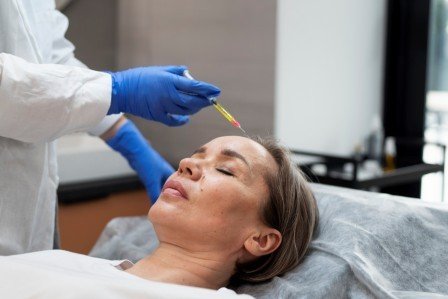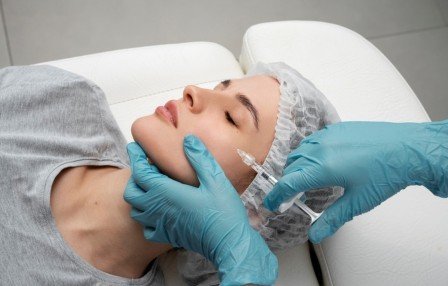Who is a Good Candidate for PRP Skin Rejuvenation?
Platelet-Rich Plasma (PRP) therapy has gained massive popularity in the field of aesthetics and dermatology over the past few years. Often referred to as the "vampire facial," this innovative treatment uses the healing power of your own blood to rejuvenate the skin, reduce the appearance of fine lines and wrinkles, improve texture, and enhance overall radiance. But while the procedure is widely praised for its natural and minimally invasive approach, it’s not necessarily ideal for everyone.
So, how do you know if PRP skin rejuvenation is right for you? In this blog, we’ll explore what PRP therapy is, how it works, and—most importantly—who makes an ideal candidate for this sought-after skin treatment.


Understanding PRP Skin Rejuvenation
PRP stands for Platelet-Rich Plasma—a substance derived from your own blood that is rich in growth factors and healing components. In PRP skin rejuvenation, a small amount of your blood is drawn and processed using a centrifuge to separate the platelets from other blood components. This concentrated platelet-rich plasma is then either injected into specific areas of the face or applied topically in combination with microneedling.
The platelets release growth factors that stimulate collagen production, increase skin cell turnover, improve blood flow, and accelerate tissue regeneration. The result is smoother, firmer, and more youthful-looking skin over time.
Key Benefits of PRP Skin Rejuvenation
Before identifying who should consider PRP therapy, it’s helpful to understand what makes the treatment so appealing:
- Stimulates collagen and elastin production
- Reduces fine lines and wrinkles
- Improves skin tone and texture
- Minimizes acne scars and stretch marks
- Enhances overall skin radiance
- Involves no chemicals or foreign substances
- Minimal downtime with low risk of side effects
Given these benefits, PRP is a favorite among those looking for a natural, science-backed method to rejuvenate their skin.
Characteristics of a Good Candidate for PRP Skin Rejuvenation
Not everyone will respond to PRP in the same way. The ideal candidate for this treatment typically meets several criteria:
1. Mild to Moderate Skin Aging
PRP is best suited for individuals experiencing early to moderate signs of aging. This includes:
- Fine lines around the eyes, mouth, or forehead
- Slight loss of elasticity or firmness
- Dull or uneven skin tone
- Minor sagging or crepiness
Because PRP stimulates your body’s natural healing processes, it works gradually. Individuals expecting dramatic, facelift-level results may be better suited for surgical procedures or more intensive treatments.
2. Good Overall Health
Since PRP is derived from your own blood and depends on your body’s natural regenerative abilities, being in good general health is important. People who are free from chronic diseases, infections, or immune disorders typically see better results and recover faster from the procedure.
Those with platelet dysfunction syndromes, blood disorders, or active infections may be advised against PRP treatment.
3. Realistic Expectations
Ideal candidates understand that PRP is not an instant fix. Unlike dermal fillers or Botox that show near-immediate results, PRP takes time to work—often requiring multiple sessions spaced a few weeks apart. Noticeable improvement typically occurs after 3–6 weeks, with continued enhancements over the following months.
Those who are patient and understand the gradual nature of this treatment are more likely to be satisfied with their results.
4. Desire for Natural-Looking Results
If you’re someone who prefers natural beauty enhancements and wants to avoid synthetic fillers or invasive procedures, PRP is an excellent option. Since it uses your own biological material, there’s minimal risk of allergic reactions or rejection.
Many patients who opt for PRP therapy appreciate that the results are subtle, organic, and steadily improve with time.
5. Early Signs of Acne Scarring or Hyperpigmentation
PRP is highly effective at improving skin texture and tone, making it a great solution for those with early acne scars or mild pigmentation issues. When combined with microneedling, it can significantly improve skin smoothness, reduce pore size, and fade dark spots or post-inflammatory marks.
6. Non-Smokers
Smoking negatively affects the body’s healing response and reduces oxygen flow in the blood, which can compromise the effectiveness of PRP therapy. Individuals who do not smoke—or those willing to quit before and after treatment—are likely to experience better outcomes.
7. Not Currently Pregnant or Breastfeeding
While PRP is a natural and generally safe treatment, it’s not recommended during pregnancy or lactation due to the body’s altered hormonal state and the lack of long-term research in these groups. Women planning to undergo PRP therapy should wait until after childbirth and breastfeeding.
Who May Not Be a Suitable Candidate?
Although PRP is widely accessible and safe, there are certain conditions and factors that may make someone ineligible or less likely to benefit:
- Blood clotting disorders or low platelet counts
- Active skin infections or severe acne outbreaks
- Cancer or undergoing chemotherapy
- Autoimmune diseases such as lupus or multiple sclerosis
- Use of blood thinners or corticosteroids
- Unrealistic expectations for immediate or dramatic results
It’s important to consult with a qualified dermatologist or aesthetic provider to determine if PRP is appropriate for your individual skin condition and health profile.
Preparing for PRP Skin Rejuvenation
If you’re considering PRP therapy, there are a few steps to take before treatment to ensure the best results:
- Hydrate well in the days leading up to your appointment to help with blood draw and circulation.
- Avoid anti-inflammatory medications like ibuprofen, as they can interfere with the healing process.
- Discontinue retinoids and exfoliants a few days before treatment to prevent skin irritation.
- Limit sun exposure to reduce sensitivity and inflammation.
What to Expect During the Procedure
The PRP session typically takes about 45 to 60 minutes:
- Blood is drawn from your arm (just like a routine blood test).
- The sample is spun in a centrifuge to isolate the platelet-rich plasma.
- The PRP is either injected into target areas or applied topically after microneedling.
- Mild redness or swelling may occur, but most patients resume normal activities the same day or the next.
For optimal results, multiple sessions (typically 3 to 4) spaced about a month apart may be recommended.
Post-Treatment Tips for Better Results
To maintain the benefits of your PRP treatment:
- Use gentle, hydrating skincare products for several days after the procedure.
- Avoid sun exposure, harsh exfoliants, or chemical peels for at least a week.
- Apply broad-spectrum SPF daily to protect the healing skin.
- Stay hydrated and maintain a balanced, nutrient-rich diet to support skin regeneration.
Final Thoughts
PRP skin rejuvenation is a safe, natural, and effective way to enhance your skin’s health and appearance. It’s especially ideal for individuals looking to address early signs of aging, acne scars, and dullness without invasive procedures or synthetic fillers.
The best candidates for PRP are in good overall health, have realistic expectations, and are committed to a series of treatments with proper aftercare. If you fit these criteria and are ready for a gentle but powerful skin transformation, PRP therapy could be the rejuvenating boost your skin needs.
Always consult with a trusted skincare professional or dermatologist to determine whether PRP is right for your skin goals.

